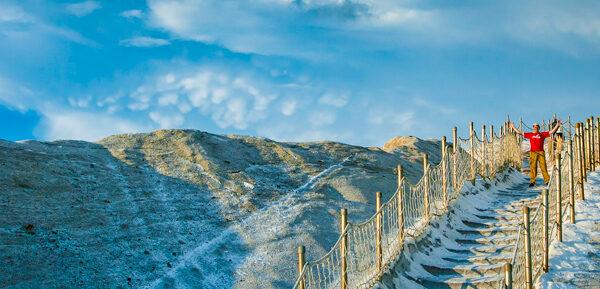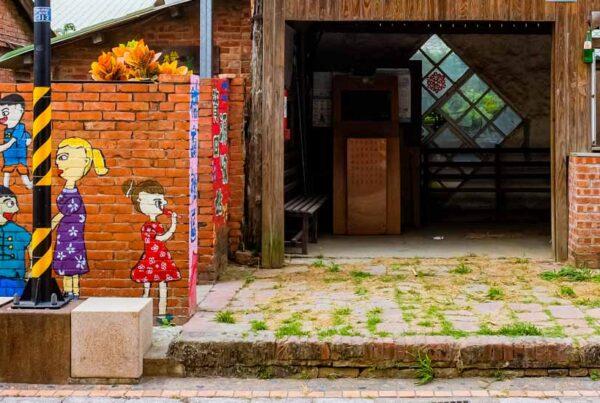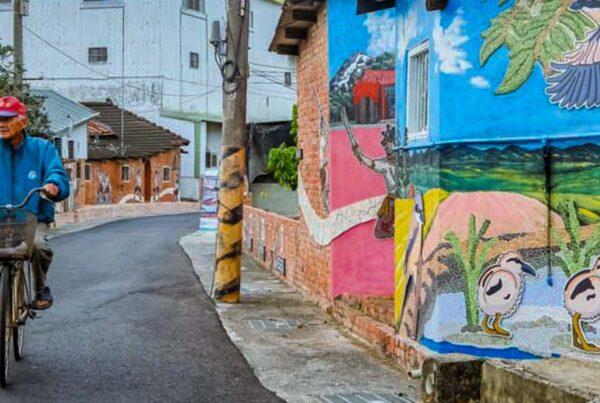A Little Town That Charms
TEXT / STEVEN CROOK
PHOTOS / VISION
A rural district in the far north of Tainan City in southwestern Taiwan, the town of Yanshui is mainly known for one particular event, the Yanshui Beehive Fireworks Festival. For the local faithful this is an important religious ritual; for the young and daring, however, it is more of a crazy thrill happening where they can test their courage. Except for this annual event, Yanshui is quiet and peaceful for most of the year, which is good news for those visitors who come to explore the town’s charming old streets and alleys.
For a good chunk of Taiwan’s modern history, i.e. since Han Chinese started migrating across the Taiwan Strait in numbers in the early 1600s, Yanshui ranked as one of the island’s four most important settlements. This status was celebrated with a local idiom, yi fu, er lu, san mengjia, si yuejin. This translates as, “First, Tainan; second, Lugang; third, Mengjia (aka Bangka, also spelled Monga, the old name for the Wanhua area in Taipei); fourth, Yuejin (the name of Yanshui’s port).”

Before the 20th century, trade between one part of Taiwan and another depended on boats. Unfortunately for Yanshui’s merchants, throughout the 19th century accumulating sediment pushed the Taiwan Strait ever further away, at the same time blocking the channels cargo vessels had to navigate to reach Yuejin port. The town ceased to be an entrepot of importance, and in the early 20th century was overtaken by places on the main north-south railroad, completed in 1908, like Xinying and Shanhua. The population of today’s Yanshui District within Tainan City is currently a little over 25,000.
Wu Temple
Because the town has never sprawled, it’s possible to walk from the northernmost attraction, the Wu (Martial) Temple, through the old downtown to the Yuejingang Riverside Park in less than 20 minutes. But it’s unlikely you’ll want to move so quickly during a tourist visit. Yanshui’s backstreets reward those willing to explore every nook and cranny.


The Wu Temple, founded in the late 17th century, is dedicated to Guan Gong, a leading light in Taiwan’s folk pantheon. Said to have been a general who lived and died in China more than 1,800 years ago – a master strategist and an individual of unimpeachable character – he’s now worshiped by businesspeople and police officers, among others.

Almost every depiction of Guan Gong shows him with a crimson complexion and a halberd-like weapon (known in Chinese as a guandao) in his hand. The larger-than-life statue of the god that stands in the grounds of the Wu Temple follows these conventions, and it’ll likely catch your eye before you notice the Yanshui Cultural Museum, a rather humdrum building located between the statue and the temple.


Much of the museum is devoted to an annual event, which the temple helps organize. The Yanshui Beehive Fireworks Festival (so called because thousands of bottle rockets fly out of each of the numerous launch-frames, rather like a mass of angry bees) celebrates the godly intervention that defeated a cholera outbreak in the town in the 1880s.
As the epidemic worsened, townsfolk urged Guan Gong to intercede. They carried effigies of the deity through the streets, burned joss paper, and hurled firecrackers in every direction to drive off the evil forces haunting them. The shock and awe campaign backed by one of heaven’s heavyweights did the trick. The disease quickly receded, but this deafening-yet-thrilling ritual has been repeated ever since, about a fortnight after the Lunar New Year.
Wu (Martial) Temple (武廟)
Add: No. 87, Wumiao Rd., Yanshui District, Tainan City
(台南市鹽水區武廟路87號)
Tel: 0925-137-596
Octagon Pavilion
The night of the “beehives” is the only time each year when outsiders inundate Yanshui, but – and this is a point I want to stress – the town is worth visiting any day of the year. The unique building known as the Octagon Pavilion, for instance, is best appreciated when there are no crowds.
This two-floor structure (the upper part is entirely made of wood) was built in 1847 for a salt-and-sugar magnate, and is still owned by his descendants. Many of the materials used in its construction, such as China fir (for the columns) and blocks of limestone, came from China as ballast on ships returning near-empty after shipping Taiwanese commodities to the mainland.


Yinfeng Ice Shop
If you’re hungry or overheating, now is a good time to make a sustenance stop. A stone’s throw from the Octagon Pavilion, the Yinfeng Ice Shop has been in business so long that local retirement-age couples can remember having their first date here. Available is a wide range of fresh juices and shaved-ice dishes to take out or enjoy on-site.

Yinfeng Ice Shop (銀鋒冰果室)
Add: No. 1, Zhongshan Rd., Yanshui District, Tainan City
(台南市鹽水區中山路1號)
Tel: (06) 652-2202
Ah-Ji Yi Mian Noodle Shop
Stomachs craving hot food should seek out the unpretentious dish that’s come to be associated with Yanshui. Yimian consists of wheat noodles usually served with some pork gravy and bean sprouts, flavored with a little crushed garlic. Portions tend to be quite small, so order a soup to go with your noodles. Alternatively, if you find yourself at the much-loved Ah-Ji Yi Mian Noodle Shop, try the “deep-fried meat packets.”

Several of the town’s best yimian eateries— including the Ah-Ji shop – are found in the neighborhood bordered by Kangle, Zhongshan, and Xinyi roads.
Ah-Ji Yi Mian Noodle Shop (阿姬意麵)
Add: No. 2-8, Zhongshan Rd., Yanshui District, Tainan City
(台南市鹽水區中山路2-8號)
Tel: (06) 652-5078
Yongcheng Theater
Having refueled, the obvious direction to go is south, to the Yongcheng Theater. This elegant and carefully restored building was originally a rice mill, but was later transformed into a place where locals could watch movies and enjoy the occasional live-theater performance.

Yuejingang Riverside Park
From the theater, it’s less than 100m to the Yuejingang Riverside Park. You’d never guess it from the site’s green and pleasant appearance (and lots of colorful lanterns during the annual Lantern Festival finishing up the traditional Chinese New Year period), but this is where the merchant junks of old used to tie up and unload.

Some of that era’s atmosphere is preserved south of the park, along the Qiaonan Old Street. Qiaonan means “south of the bridge,” and the street is said to be Yanshui’s oldest thoroughfare. At least a dozen of the single-story houses here, mainly built of wood, predate the official closure of the port in 1900.
Holy Trinity Catholic Church
The Yanshui Beehive Fireworks Festival has its roots in local folk religion, but Yanshui also boasts what’s probably Taiwan’s most remarkable Christian place of worship, the Holy Trinity Catholic Church. The interior is as dazzlingly colorful as the most ornate Buddhist or Daoist temple. Zoom in on the mural of The Last Supper: The men have Asian faces and hairstyles, wear traditional Chinese clothes, and eat steamed buns with chopsticks.

Holy Trinity Catholic Church (鹽水天主堂)
Add: No. 19, Ximen Rd., Yanshui District, Tainan City
(台南市鹽水區西門路19號) (closed Monday and Tuesday)
Tel: (06) 652-1174
Taiwan Poetry Road
If you have your own set of wheels and are moving southward, about 7km outside the town, along Provincial Highway 19, you might want to make a stop at Taiwan Poetry Road. For international visitors, the main attraction here isn’t the literary angle, but rather the Bombax ceiba (kapok or red silk-cotton) trees. For a few weeks in early spring they’re crowned with beautiful orange-red flowers.

Getting There
If you don’t have your own means of transport, you’ll find getting to Yanshui by public transportation is a piece of cake. Take a train to Xinying Railway Station, walk to the bus station not far from the train station, and board one of the 50-plus Brown Line services each day for the 20-minute journey to Yanshui.
About the author

Steven Crook
Steven Crook, who grew up in England, first arrived in Taiwan in 1991. Since 1996, he’s been writing about Taiwan’s natural and cultural attractions for newspapers and magazines, including CNN Traveler Asia-Pacific, Christian Science Monitor, and various inflight magazines. He’s the author of four books about the country: Keeping Up With The War God (2001), Dos And Don’ts In Taiwan (2010), Taiwan: The Bradt Travel Guide (2010), and A Culinary History of Taipei: Beyond Pork and Ponlai (2018)
http://crooksteven.blogspot.com
http://bradttaiwan.blogspot.com















